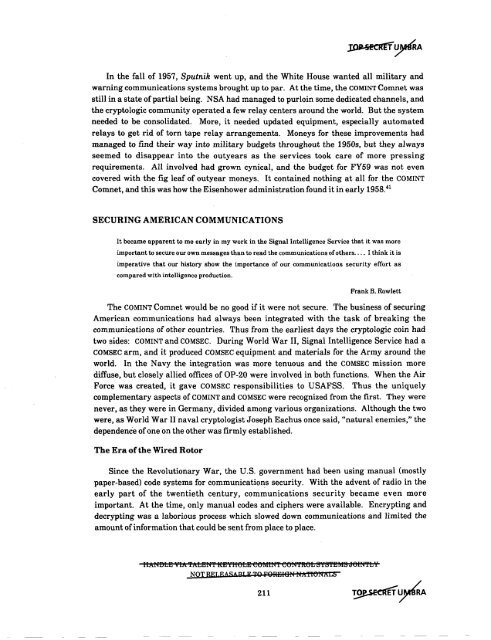American Cryptology during the Cold War - The Black Vault
American Cryptology during the Cold War - The Black Vault
American Cryptology during the Cold War - The Black Vault
You also want an ePaper? Increase the reach of your titles
YUMPU automatically turns print PDFs into web optimized ePapers that Google loves.
In <strong>the</strong> fall of 1957, Sputnik went up, and <strong>the</strong> White House wanted all military and<br />
warning communications systems brought up to par. At <strong>the</strong> time, <strong>the</strong> COMINT Comnet was<br />
still in a state ofpartial being. NSA had managed to purloin some dedicated channels, and<br />
<strong>the</strong> cryptologic community operated a few relay centers around <strong>the</strong> world. But <strong>the</strong> system<br />
needed to be consolidated. More, it needed updated equipment, especially automated<br />
relays to get rid of torn tape relay arrangements. Moneys for <strong>the</strong>se improvements had<br />
managed to find <strong>the</strong>ir way into military budgets throughout <strong>the</strong> 1950s, but <strong>the</strong>y always<br />
seemed to disappear into <strong>the</strong> outyears as <strong>the</strong> services took care of more pressing<br />
requirements. All involved had grown cynical, and <strong>the</strong> budget for FY59 was not even<br />
covered with <strong>the</strong> fig leaf of outyear moneys. It contained nothing at all for <strong>the</strong> COMINT<br />
Comnet, and this was how <strong>the</strong> Eisenhower administration found it in early 1958. 41<br />
SECURING AMERICAN COMMUNICATIONS<br />
It became apparent to me early in my work in <strong>the</strong> Signal Intelligence Service that it was more<br />
important to secure our own messages than to read <strong>the</strong> communications ofo<strong>the</strong>rs.... I think it is<br />
imperative that our history show <strong>the</strong> importance of our communicatioJ:1s security effort as<br />
compared with intelligence production.<br />
Frank B. Rowlett<br />
<strong>The</strong> COMINT Comnet would be no good if it were not secure. <strong>The</strong> business of securing<br />
<strong>American</strong> communications had always been integrated with <strong>the</strong> task of breaking <strong>the</strong><br />
communications of o<strong>the</strong>r countries. Thus from <strong>the</strong> earliest days <strong>the</strong> cryptologic coin had<br />
two sides: COMINT and COMSEC. During World <strong>War</strong> II, Signal Intelligence Service had a<br />
COMSEC arm, and it produced COMSEC equipment and materials for <strong>the</strong> Army around <strong>the</strong><br />
world. In <strong>the</strong> Navy <strong>the</strong> integration was more tenuous and <strong>the</strong> COMSEC mission more<br />
diffuse, but closely allied offices of OP-20 were involved in both functions. When <strong>the</strong> Air<br />
Force was created, it gave COMSEC responsibilities to USAFSS. Thus <strong>the</strong> uniquely<br />
complementary aspects of COMINT and COMSEC were recognized from <strong>the</strong> first. <strong>The</strong>y were<br />
never, as <strong>the</strong>y were in Germany, divided among various organizations. Although <strong>the</strong> two<br />
were, as World <strong>War</strong> II naval cryptologist Joseph Eachus once said, "natural enemies," <strong>the</strong><br />
dependence ofone on <strong>the</strong> o<strong>the</strong>r was firmly established.<br />
<strong>The</strong> Era of<strong>the</strong> Wired Rotor<br />
Since <strong>the</strong> Revolutionary <strong>War</strong>, <strong>the</strong> U.S. government had been using manual (mostly<br />
paper-based) code systemsfor communicatio~ssecurity. With <strong>the</strong> advent of radio in <strong>the</strong><br />
early part of <strong>the</strong> twentieth century, communications security became even more<br />
important. At <strong>the</strong> time, only manual codes and ciphers were available. Encrypting and<br />
decrypting was a laborious process which slowed down communications and limited <strong>the</strong><br />
amount ofinformation that could be sent from place to place.<br />
IIA:!qf'LI!: VIA: 'fA:LI!lf('f Itl!lYII6LI!l eOMIn'f e6!qTftOL S fS'fI!lMS JOHq'fLY<br />
NOT REI.EASA HI F 1''' il"RI'JI8H !(JtTI6NALS<br />
211
















